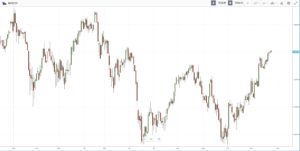The ASX200 continued its resilient performance in 2022, adding another 1.5 per cent last week, taking its loss for the year to just 2.5 per cent. All four big banks finished in the green, helping to boost the financial sector by 2 per cent, but utilities led the way climbing more than 5%. Overseas, despite a shorter week for Thanksgiving, the S&P500 added 1.5% for the week, whilst the Dow continued its recovery, gaining 1.8%, trimming its loss for the year to just 5.5%.
3 things that happened last week:
1. RBA Lowe’s Speech
Last week, The Reserve Bank of Australia Governor Philip Lowe reinforced the bank’s expectation that inflation will peak at 8% by the end of the year. He did, however, note that rate cuts are on the horizon with a few major factors at play. The first was the easing of supply chain disruptions, the second was the stabilisation of commodity prices, and finally, that interest rates would result in slower growth in aggregate demand and ultimately lead to lower inflation. One of the biggest concerns that Dr Lowe pointed to in his speech was the potential of wages spiralling as workers demand pay increases in order to deal with the growing cost of living pressures. He said, “If we all buy into the idea that wages have to go up to compensate people for inflation, it will be painful.”
2. Qantas upgrades profit forecasts
Just weeks after its initial forecasts, Qantas last week raised its profit outlook for the final six months of 2022. This is a clear indication that even with sky-high airfares, travel demand is strong and will continue into early next year. It also serves as an indication of the resilience of the average consumer, who continues to spend despite the rising cost of living pressures. This may be amplified by years of travel restrictions due to COVID-19 conditions. Following a difficult period during the pandemic, Qantas appears to be turning its fortunes around. Its profit forecast has been increased by $150 million to between $1.35 billion and $1.45 billion, which means its dividend could very likely be reinstated in 2023. As a result, Qantas may be able to further narrow its debt, with forecasts of net debt expected to fall to $2.5 billion by the end of the year.
3. A winner and loser last week from the S&P/ASX200
Virgin Money UK PLC added 23.81% last week after it released better-than-expected financial results and announced a buy-back of over £50 million. Virgin reported adjusted pretax profit of £789 million for the year and upgraded its outlook.
Pilbara Minerals fell 6.3% last week alongside some other big lithium names. Bearish comments from Credit Suisse and Goldman Sachs regarding lithium prices likely drove the sell-off as well as further lockdowns in China.

3 things to watch for the week ahead:
1. Australian Monthly CPI
Australia’s recently introduced monthly CPI reading is released on Wednesday (Nov. 30), giving investors another look under the hood of inflation. Last month saw a reading of 7.3 per cent, the highest in decades, but estimates have another hot print of 7.5 per cent, moving closer to the RBA’s peak estimate of 8 per cent by the end of the year. Unfortunately for the RBA, last week’s unemployment rate and recent higher-than-expected wage growth haven’t helped the bank’s inflation headache. Although inflation is rising, the pressures are coming from high commodity prices on fuel and construction costs, and rising food prices. These look like short-term price shocks that could reverse in the months ahead, particularly with oil prices already falling by 15 per cent in the last three months. Australia currently has lower inflation than the United States and most major EU regions. This makes the RBA’s task of containing high inflation without triggering a recession less challenging when compared to, say, the US. A hotter reading would likely point towards another 25bps move in December, but a number lower than 7.5 per cent could see another move lower from the RBA.
2. Retail Sales Data
So far in 2022, the Australian consumer has remained resilient in the face of soaring inflation and rising interest rates, but the key question is how long this can continue. On Monday (Nov. 28), retail sales data will be released and is expected to show another month of gains at 0.5 per cent. This would mean a tenth consecutive month of gains as households continue to spend, supporting the RBA’s view that householders are in a solid position to weather higher borrowing costs. Last month’s reading showed strength from clothing and footwear, up 2 per cent, while eating out was also at the top of Aussies’ list, with cafes, restaurants and takeaway services up 1.3 per cent. Spending patterns are being monitored closely by the RBA to see if their consecutive rate hikes are cooling demand. However, given elevated household savings from the pandemic and growing incomes, the belt-tightening narrative is yet to be shown in spending data.
3. China Zero Covid
Despite COVID being in the rear mirror for most nations, China this week recorded its highest-ever daily case number of 29,754, with major cities entering into lockdowns. But, times could be changing with the government looking to boost its struggling economy with plans to offer financial aid to rescue its property sector. This week, the state council agreed to a ‘RRR’ cut, which means cutting the amount of cash banks keep in reserve. However, this would likely be a short-term boost and the real hurdle lies in ending its Zero Covid Policy to bolster economic growth once again. Chinese stocks are some of the worst performing this year, with the CSI 300 down 24 per cent and the Hang Seng down 25 per cent. This latest news will likely mean further volatility into this week, but a shift in policy to re-prioritise economic growth could open up opportunities for investors, as these assets are cheap and under-owned given the current risks.
*All data accurate as of 28/11/2022. Data Source: Bloomberg and eToro
Disclaimer:
This communication is general information and education purposes only and should not be taken as financial product advice, a personal recommendation, or an offer of, or solicitation to buy or sell, any financial product. It has been prepared without taking your objectives, financial situation or needs into account. Any references to past performance and future indications are not, and should not be taken as, a reliable indicator of future results. eToro makes no representation and assumes no liability as to the accuracy or completeness of the content of this publication.

